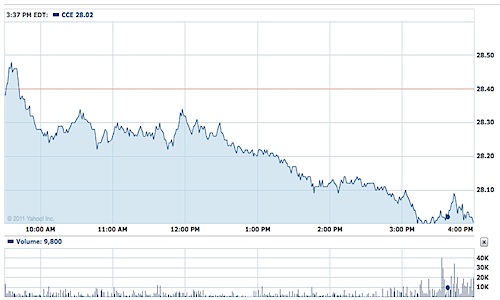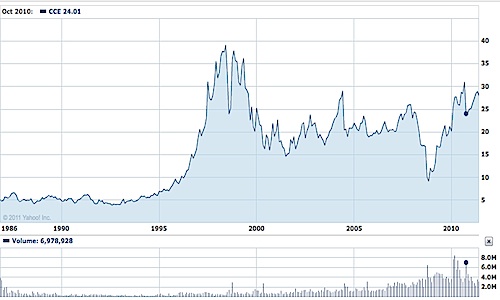There are few things better in life than receiving money in the mail or in your account. Perhaps one thing better would be to know that you’d be receiving cash with some regularity — about every 90 days or so. Or that you too, can sign up for this flow of free money. Sounds enticing?
Many Mid and Large Cap companies operate a type of profit sharing program for their stock holders. In fact, we’ve talked about it here when we presented this piece on cheap ways to purchase dividend stocks. Every 90 days, the company takes a percentage of last quarter’s profits, and distributes that money equally among its shareholders. This is called a dividend. A company’s dividend per share is often a small amount of money, ranging from a few pennies to several dollars per share.
Oftentimes, these dividend paying companies offer re-investment programs. By signing an enrollment form, the company will then take the proceeds of your check and purchase additional shares, crediting them to your account.
How I Got Started With Dividend Reinvestment Programs
I was first introduced to Dividend Re-investment Plans (or Programs, also called DRIPs for short) in 1996, when I was “gifted” 5 shares of Pepsico. At the time, the shares were trading around $36. I’ll take a ~$150 gift, wouldn’t you? Pepsico paid dividends of just $0.125 per share in 1997. My first dividend check was worth a whopping $0.63! I opted into the DRIP and my $0.63 acquired .0165 shares of Pepsico stock. Woo Hoo! 😉 But wait. The good news is that this extra money was working for me too.
Only able to save between $25 to $50 a week, I was able to buy nearly 9 more shares in the Fall with an additional $325 investment. The following month ended the quarter, and I now held 14 shares; the plan subsequently paid $1.75, and credited me with .0451 shares. Still nothing to write home about.
But the point here is that a consistent program can build and then compound your investment’s growth over time. Fast forward to Spring of 1999, and an additional $500 investment over that time period boosted my holdings to 21 shares. The dividend rate had increased to $0.13 / share and got my check up to $3.41. The price of the stock was now around $40. Big deal you say?
What started as a $150 gift and with another $500 added to it (so $650 in actual contributions) was now worth over $1,000. That’s a $350 gain in about 18 months, pretty much a 100% gain. Looking at my most recent statement, that same company is now paying nearly $0.50 per share in dividends, and trading near $65 on the stock market. This was a successful play that involved a stock whose dividends AND stock price were both on the rise.
In a simplistic way, this is called compounding (the more elaborate explanation is here). When your money makes money on an ongoing fashion, then you’re seeing solid growth on your investment. That’s what a DRIP aims to do for you.
Where To Go For A DRIP
How do you get started with a Dividend Re-investment Plan? Investing in stocks is so much easier than it was in previous years. Today, there are about a thousand companies that offer a Dividend Re-investment Plan, and many of them can be purchased directly through their transfer agent. Furthermore, there are a handful of transfer agents that handle the majority of company stock transfers. So here are 2 quick ways to get going with a DRIP:
- Check out a stock transfer agent like Computershare Limited or BankMellon, which are main players. They may be able to assist you with a program. Check out this link for more information.
- You can also visit a particular company’s website to locate the transfer agent they use, or you can contact them for more information about their DRIP. Call the investor relations representative and let them know you are interested in acquiring stock, and that you want to enroll in their Dividend Re-investment Plan. The rep should be able to walk you through the steps. See this list of companies with no fee DRIPs.
How To Find Companies With A Dividend Reinvestment Program
With a thousand or so companies to choose from, which ones should you ultimately select?
- Start off by looking around you to see which products or services stand out. Are you using a Mac or a Dell? Logitech mouse? Is there a Panasonic TV in your room? What about the cell phone you carry with you, the car you drive, the coffee … well, you get the idea.
- Do the research, of course. Now that you’ve identified some companies, look them up on the web, (AOL, Yahoo, Google), and do some research on the company. After all, shouldn’t the owner know a bit about the company he or she owns? Find out about its financial health by looking at the debt to earnings ratio. Make sure that the company is not spending more than it’s making.
- Look at a few long term charts. The health of a company that has been in business for 1, 2 or even 5 decades won’t be apparent if you’re looking at a daily chart. Here is a daily chart of Coca Cola stock (CCE) for June 2nd 2011. This chart looks pretty unfriendly. You wouldn’t want to make conclusions from this though, unless you’re a day trader.

CCE Daily ChartLooking at a 15 year chart of CCE, however, will make you see the bigger picture. This view can be much more revealing, as it shows the growth and hiccups of this particular investment. You’ll want to compare Coca Cola’s performance against other stocks in a Dividend Reinvestment Program before you make decisions.

CCE Long Term Performance Chart - Look for companies that have consistently grown dividends. Obviously, the better the return, the quicker you build wealth. Companies like RPM that make the well known product Rustoleum have increased dividends consecutively for the last 35 years, and are doing something right. These are companies that you may want a piece of.
- Monitor the markets and your environment. Look and listen to what’s going on around you, your state, region and nation. Keep an eye on the global markets and news as well. The world around us leaves clues for us to find and use. For example, the price of gas is rising exponentially it seems, and those of us who understand and are aware of peak oil scenarios (like how it was several years ago) are working to see how to play this situation. There are several oil and petroleum companies that offer DRIPs, and you may want to check them out if you believe that the price of oil and gas will continue to rise in the coming years.
Even after all these years, I still get a smile when I go to the mailbox and see an envelope from a company I own. It means that they paid me recently. And that’s always fun.
Copyright © 2011 The Digerati Life. All Rights Reserved.

{ 2 comments… read them below or add one }
Some DRIPs offer a discount when you DRIP too 🙂 But not for Questrade (A Canadian discount brokerage). Not only do you not have to pay trading fees, but you get a 5% discount in some cases.
An even better way to maximize your money! Thanks for the comment, Young!